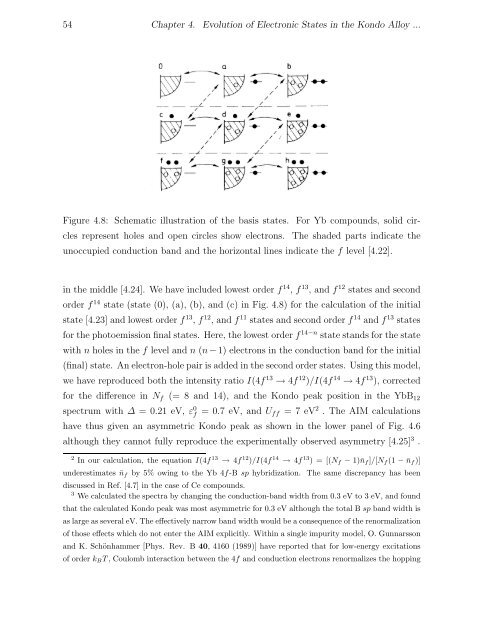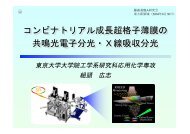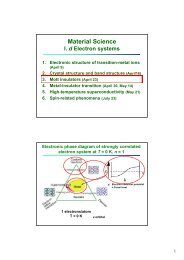Thesis High-Resolution Photoemission Study of Kondo Insulators ...
Thesis High-Resolution Photoemission Study of Kondo Insulators ...
Thesis High-Resolution Photoemission Study of Kondo Insulators ...
Create successful ePaper yourself
Turn your PDF publications into a flip-book with our unique Google optimized e-Paper software.
54 Chapter 4. Evolution <strong>of</strong> Electronic States in the <strong>Kondo</strong> Alloy ...<br />
Figure 4.8: Schematic illustration <strong>of</strong> the basis states. For Yb compounds, solid circles<br />
represent holes and open circles show electrons. The shaded parts indicate the<br />
unoccupied conduction band and the horizontal lines indicate the f level [4.22].<br />
in the middle [4.24]. We have included lowest order f 14 , f 13 , and f 12 states and second<br />
order f 14 state (state (0), (a), (b), and (c) in Fig. 4.8) for the calculation <strong>of</strong> the initial<br />
state [4.23] and lowest order f 13 , f 12 , and f 11 states and second order f 14 and f 13 states<br />
for the photoemission final states. Here, the lowest order f 14−n state stands for the state<br />
with n holes in the f level and n (n − 1) electrons in the conduction band for the initial<br />
(final) state. An electron-hole pair is added in the second order states. Using this model,<br />
we have reproduced both the intensity ratio I(4f 13 → 4f 12 )/I(4f 14 → 4f 13 ), corrected<br />
for the difference in Nf (= 8 and 14), and the <strong>Kondo</strong> peak position in the YbB12<br />
spectrum with ∆ = 0.21 eV, ε0 f = 0.7 eV, and Uff =7eV2 . The AIM calculations<br />
have thus given an asymmetric <strong>Kondo</strong> peak as shown in the lower panel <strong>of</strong> Fig. 4.6<br />
although they cannot fully reproduce the experimentally observed asymmetry [4.25] 3 .<br />
2 13 12 14 13 In our calculation, the equation I(4f → 4f )/I(4f → 4f )=[(Nf−1)¯nf]/[Nf (1 − ¯nf )]<br />
underestimates ¯nf by 5% owing to the Yb 4f-B sp hybridization. The same discrepancy has been<br />
discussed in Ref. [4.7] in the case <strong>of</strong> Ce compounds.<br />
3 We calculated the spectra by changing the conduction-band width from 0.3 eV to 3 eV, and found<br />
that the calculated <strong>Kondo</strong> peak was most asymmetric for 0.3 eV although the total B sp band width is<br />
as large as several eV. The effectively narrow band width would be a consequence <strong>of</strong> the renormalization<br />
<strong>of</strong> those effects which do not enter the AIM explicitly. Within a single impurity model, O. Gunnarsson<br />
and K. Schönhammer [Phys. Rev. B 40, 4160 (1989)] have reported that for low-energy excitations<br />
<strong>of</strong> order kBT , Coulomb interaction between the 4f and conduction electrons renormalizes the hopping






